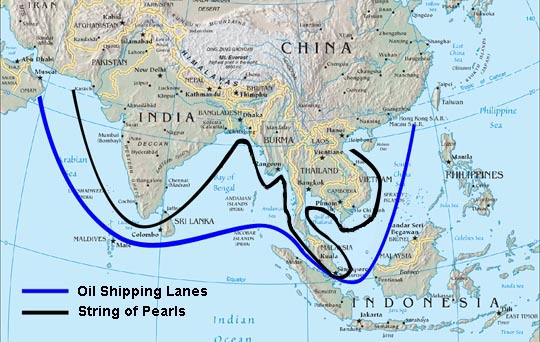Before Going to the excerpts, let me crystalise what is String of Pearl strategy of China
the string of pearls strategy is basically a grand Chinese plan to build a Chinese dominated hegemony in the Indian ocean region by supporting militarily and economically many nations in the Indian ocean rim in return for military privileges some of the pearls on this string are
1-the Chinese intelligence gathering post at the cocos islands off Myanmar
2-the Chinese built naval ports at gwadar and pasni ain pakistan , not to mention the Chinese built nuclear power plants and defense industries in that country.
3-the Chinese support to Nepalese maoists.
4-the Chinese support in terms of weapon sales to many east African nations.
5-the Chinese are reported to be building a port at srilanka as well.
China’s String of Pearls Strategy

Mar. 18 – China’s “string of pearls” strategy appears to be taking another step forward as Beijing increases ties with the Sri Lankan government. The strategy, which was the subject of a 2005 U.S. China Commission report to Congress, is driven by China’s need to secure foreign oil and trade routes critical to its development. This has meant establishing an increased level of influence along sea routes through investment, port development and diplomacy.
To date, China’s investments extend from Hainan Island in the South China Sea, through the littorals of the Straits of Malacca, including port developments in Chittagong in Bangladesh; Sittwe, Coco, Hianggyi, Khaukphyu, Mergui and Zadetkyi Kyun in Myanmar; Laem Chabang in Thailand; and Sihanoukville in Cambodia. They extend across the Indian Ocean, Sri Lanka, the Maldives, Pakistan’s Gwadar Port, and in islands within the Arabian Sea and into the Persian Gulf.
Not surprisingly, both the U.S. and Indian governments are concerned, part of these developments include the upgrading of airstrips, many supported with military facilities, such as the facility on Woody Island, close to Vietnam. These developments mean that the balance of power within the Indian and Arabian Gulf has now shifted away from the traditional Indian government management, backed up with U.S. military strength, but to China, backed up with regional diplomatic ties that dispense with the need to engage with either power.
The strategy has been developed partially in response to a lack of progress on the Kra Canal project in Thailand, which would directly link the Indian Ocean with the South China Sea. The “string of pearls” strategy however provides a forward presence for China along the sea lines of communication that now anchor China directly to the Middle East. The question both the United States and India have is whether this strategy is intended purely to cement supply lines and trade routes, or whether China will later use these in a bid to enforce regional supremacy.
India has not been an innocent party to the development of the “string of pearls.” Somewhat foolishly, it threatened to cut off China’s choke point for oil and trade – the Malacca Straits – in both 1971 and 1999, when it moved to blockade Karachi Port which at the time handled 90 percent of Pakistan’s sea trade, including oil supplies to China. India has also recently attempted to persuade the Sri Lankan government not to permit Chinese development of the country’s Hambantota Port, a project that is now well underway. Chinese investment in Sri Lanka is also likely to significantly increase given the likely conclusion of the civil war, and Chinese interests in drilling for oil off the coast of Northeast Sri Lanka.
As America’s influence in the region wanes, China’s strategy appears to be conservatively supported by other Southeast Asian nations, with the potential exception of India. Pro-U.S. nations such as Japan, South Korea, Australia and the Philippines find it in their own self interests to improve and develop ties with China, while nations such as Pakistan, Vietnam, Myanmar and Cambodia are all strong allies of Beijing. The growing perception is that a peaceful region does not now necessarily require a U.S. military presence.
Concerns remain however. Chinese fishing trawlers have been uncovered mapping the ocean floor to facilitate submarine operations, and disputes over territorial waters are increasing as the recent standoff between an American survey ship and Chinese vessels in the South China Sea demonstrates. The United States insists it was operating in international waters, the Chinese claim the incident occurred within their exclusive economic zone. India feels threatened by the perception of a China increasingly encircling the country, with Tibet to the north, a China supported Myanmar regime to the east, an increasingly China-dependent Bangladesh beginning to emerge, and the long standing support China has shown for Pakistan. Given India’s own huge security problems with Pakistan it is unlikely, unless they can influence Sri Lanka, that the Indian government will be able to do much about the development of China’s interest within the region.
As long as Chinese interests remain benign, the “string of pearls” strategy remains the strongest pointer yet that China is both anchoring its energy supply lines with the Middle East and embarking on a level of Southeast Asian trade – and the development of regional prosperity that will come with it – on a scale never seen before. If the strategy continues without the development of regional conflicts, the ASEAN trading bloc, with China at its heart, and the massive emerging markets of India and the other Southeast Asian nations close by, will develop and begin to rival that of the EU and the United States, and lessen China’s dependence on these traditional export markets.
for more visit: http://www.worldaffairsboard.com/pacific-rim-rise-china/46783-china-string-pearls-strategy.html
for more visit: http://www.worldaffairsboard.com/pacific-rim-rise-china/46783-china-string-pearls-strategy.html
No comments:
Post a Comment